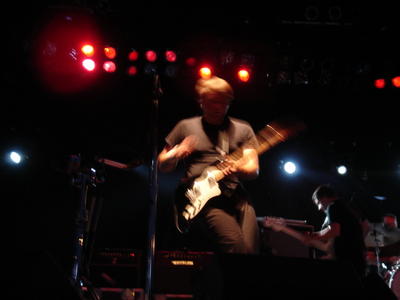The Hideout has graciously picked up my July 1 article "Not Just A Hole In The Wall" for their press section. This is my second article to be included on the club's website. The first was a Top 5 Chicago Clubs article I did for DePaul University's newspaper The DePaulia where I ranked The Hideout #2 on the list. Thank you to The Hideout for adding Getting In Tune.
The Hideout has also announced the early lineup for the 9th annual Hideout Block Party, set to begin on Saturday, September 17. So far the bill includes The dB's, Nomo, The Sam Roberts Band, The M's, and The Redwalls. Check out The Hideout website located in the links field for further information.
Wednesday, July 27, 2005
Tuesday, July 26, 2005
Lollapalooza @ Grant Park (7/23-24/2005)
 The long awaited return of Lollapalooza came this past weekend in Grant Park. Perry Farrell's rock and roll circus made a home for itself along Chicago's lakefront, surviving rain and excessive heat warnings. Located in Hutchinson Field, the two day festival drew a crowd of 66,000 to see sixty of music's elite and rising artists on five separate stages in the park's south end. After last year's cancelled tour, Lollapalooza seems to have found new life, but some critics might say the festival's past is still holding it back from becoming one of the most attractive music events of the summer.
The long awaited return of Lollapalooza came this past weekend in Grant Park. Perry Farrell's rock and roll circus made a home for itself along Chicago's lakefront, surviving rain and excessive heat warnings. Located in Hutchinson Field, the two day festival drew a crowd of 66,000 to see sixty of music's elite and rising artists on five separate stages in the park's south end. After last year's cancelled tour, Lollapalooza seems to have found new life, but some critics might say the festival's past is still holding it back from becoming one of the most attractive music events of the summer.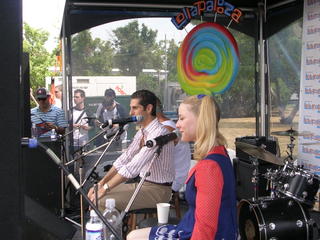 Early Saturday morning the city received some welcomed rain after consecutive days of high humidity and very little relief. For the organizers of Lollapalooza, the rain was probably not on their schedule. In a way, the downpour acted as a baptism for this much heralded festival. The lost summer Lollapalooza experienced in 2004 because of poor ticket sales forced its creator, Perry Farrell, to reinvent his traveling musical revue. With the aid of Capital Sports & Entertainment (CSE) and Charles Attal Presents, Lollapalooza received an overhaul. The two entertainment organizations, both based in Austin, Texas, came into Lollapalooza's life with a serious knowledge of how to make a festival work having had enormous success with the Austin City Limits Music Festival, now entering its third year. Instead of a multi-city festival, Lollapalooza's wide scope was downsized into a more focused approach. On April 22, 2005, plans were finally secured and an annoucement was made that revealed Chicago as the new official home for Lollapalooza.
Early Saturday morning the city received some welcomed rain after consecutive days of high humidity and very little relief. For the organizers of Lollapalooza, the rain was probably not on their schedule. In a way, the downpour acted as a baptism for this much heralded festival. The lost summer Lollapalooza experienced in 2004 because of poor ticket sales forced its creator, Perry Farrell, to reinvent his traveling musical revue. With the aid of Capital Sports & Entertainment (CSE) and Charles Attal Presents, Lollapalooza received an overhaul. The two entertainment organizations, both based in Austin, Texas, came into Lollapalooza's life with a serious knowledge of how to make a festival work having had enormous success with the Austin City Limits Music Festival, now entering its third year. Instead of a multi-city festival, Lollapalooza's wide scope was downsized into a more focused approach. On April 22, 2005, plans were finally secured and an annoucement was made that revealed Chicago as the new official home for Lollapalooza.The rain had cleared up by about 9:30 A.M. The sun fought its way through some clouds as the hour drew closer for the day's first two performers, The Redwalls and The (International) Noise Conspiracy, to launch Day One. During a pre-show press conference, Charlie Jones, a spokesperson for CSE, described Grant Park as Chicago's "crown jewel," and expressed the hopes of the organizers to make Lollapalooza "the greatest fest in the country." For Perry Farrell, it had been a long journey since 1991, when the festival was first started. In a city where rock bands like The Smashing Pumpkins were denied entry into its prized park to perform for free, Chicago did not simply turn a cheek lightly when the idea to hold Lollapalooza was presented. What made performances by Sting and Shania Twain get the free pass into Grant Park was the major incentive the city would get in return: money. "It was like a beautiful woman," said Farrell on courting the city government. "She took her time." It is reported that the promoters' deal with the city outlined a donation of $250,000 to the Parkways Foundation, the presenters of Lollapalooza.
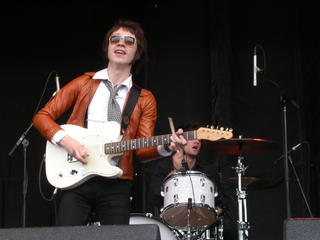 Fresh from a supporting slot for Oasis on their U.K. stadium tour, The Redwalls had the distinct honor of being the first local act to start the day. Going from Metro to Manchester Stadium was quite a leap for this four piece out of Deerfield, IL. Set to play at 11:45 A.M., generally not an hour to play a concert, The Redwalls took to their stage with sheer confidence. Liam Gallagher of Oasis must have had made an impact on Redwalls guitarist Logan Baren who seemed to take on some of the Oasis frontman's stage mannerisms and vocal swagger, not to mention wearing sunglasses presented to him by the younger Gallagher. "I think we would have been more nervous if we hadn't done the Oasis thing," said bassist Justin Baren, younger brother to Logan, about the prospect of playing to a large outdoor crowd. The band was welcomed by a strong sized crowd that surpassed any concerns the band may have had on the early time slot. Said Justin after the band's set, "I was nervous that not a lot of people would show up that early, but it turned out great."
Fresh from a supporting slot for Oasis on their U.K. stadium tour, The Redwalls had the distinct honor of being the first local act to start the day. Going from Metro to Manchester Stadium was quite a leap for this four piece out of Deerfield, IL. Set to play at 11:45 A.M., generally not an hour to play a concert, The Redwalls took to their stage with sheer confidence. Liam Gallagher of Oasis must have had made an impact on Redwalls guitarist Logan Baren who seemed to take on some of the Oasis frontman's stage mannerisms and vocal swagger, not to mention wearing sunglasses presented to him by the younger Gallagher. "I think we would have been more nervous if we hadn't done the Oasis thing," said bassist Justin Baren, younger brother to Logan, about the prospect of playing to a large outdoor crowd. The band was welcomed by a strong sized crowd that surpassed any concerns the band may have had on the early time slot. Said Justin after the band's set, "I was nervous that not a lot of people would show up that early, but it turned out great."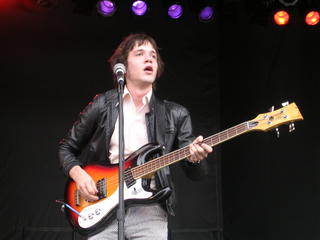
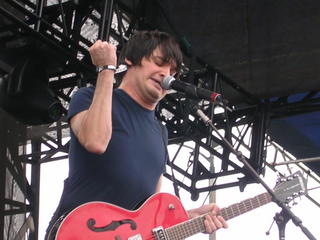 Following The (International) Noise Conspiracy's set was ...And You Will Know Us By The Trail Of Dead. The band furiously attacked the afternoon by making the most of their hour set, trashing their instruments in the end. Walking the grounds between stages provided a chance to see at what point the sound from opposite stages bled into each other. If one were to stand in the middle of the field, they would get a mix of both stages. The closer you were to a particular stage the less likely you would hear the other act performing across the field. Being that every band faced simultaneous time slots they couldn't help but notice another artist on their time.
Following The (International) Noise Conspiracy's set was ...And You Will Know Us By The Trail Of Dead. The band furiously attacked the afternoon by making the most of their hour set, trashing their instruments in the end. Walking the grounds between stages provided a chance to see at what point the sound from opposite stages bled into each other. If one were to stand in the middle of the field, they would get a mix of both stages. The closer you were to a particular stage the less likely you would hear the other act performing across the field. Being that every band faced simultaneous time slots they couldn't help but notice another artist on their time.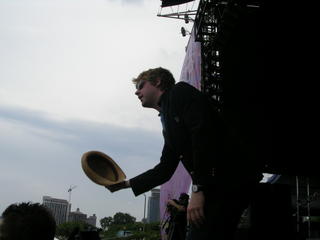 Singer Ricky Wilson of the Kaiser Chiefs pointed out this very fact when over at the SBC West stage Liz Phair began her performance. As brash as he was amusing, Wilson inquired who that "lady" was on the neighboring stage. Fans yelled out to Wilson, "Liz Phair!" He glanced over to Phair's side of the field and recommended she keep it down. "Tell her we're working," said Wilson. The band thrashed through their set as their singer pushed the limits of his already shredded voice ("I left my voice in Washington last night," said Wilson). Wilson later climbed the stage supports and turned the microphone over to two fans after his voice finally gave out.
Singer Ricky Wilson of the Kaiser Chiefs pointed out this very fact when over at the SBC West stage Liz Phair began her performance. As brash as he was amusing, Wilson inquired who that "lady" was on the neighboring stage. Fans yelled out to Wilson, "Liz Phair!" He glanced over to Phair's side of the field and recommended she keep it down. "Tell her we're working," said Wilson. The band thrashed through their set as their singer pushed the limits of his already shredded voice ("I left my voice in Washington last night," said Wilson). Wilson later climbed the stage supports and turned the microphone over to two fans after his voice finally gave out.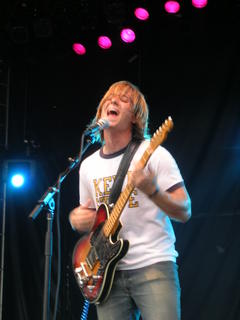 Liz Phair, on the other hand, lacked all the spontaneity the Kaiser Chiefs displayed during their set. Phair, who has long since left Chicago for Los Angeles, walked through her set with little excitement. Her backing band almost reduced Phair to some coffee house open-mic performer. A new song called "Everything To Me" was close to being jettisoned due to her guitarist having issues with his guitar. There was some confusion when Phair announced she would tackle a song on her own. As if unsure what to do, her bassist and drummer stepped into what was supposed to be a solo Phair doing "6'1"" while her guitarist figured out his problems. It would have been a nice treat if Phair had in fact dumped "Everything To Me." What will no doubt become a single from her upcoming album, the song screamed of something Sheryl Crow would have written for her cycling boyfriend Lance Armstrong. It's hard to even associate Phair with Chicago anymore. Her stale performance gave all the more reason why Phair didn't deserve a spot on the Lollapalooza bill. She can test the boundaries of human sexuality in song all she wants but commanding a festival sized stage she can not. At least John Cusack had a good view from the side of the stage.
Liz Phair, on the other hand, lacked all the spontaneity the Kaiser Chiefs displayed during their set. Phair, who has long since left Chicago for Los Angeles, walked through her set with little excitement. Her backing band almost reduced Phair to some coffee house open-mic performer. A new song called "Everything To Me" was close to being jettisoned due to her guitarist having issues with his guitar. There was some confusion when Phair announced she would tackle a song on her own. As if unsure what to do, her bassist and drummer stepped into what was supposed to be a solo Phair doing "6'1"" while her guitarist figured out his problems. It would have been a nice treat if Phair had in fact dumped "Everything To Me." What will no doubt become a single from her upcoming album, the song screamed of something Sheryl Crow would have written for her cycling boyfriend Lance Armstrong. It's hard to even associate Phair with Chicago anymore. Her stale performance gave all the more reason why Phair didn't deserve a spot on the Lollapalooza bill. She can test the boundaries of human sexuality in song all she wants but commanding a festival sized stage she can not. At least John Cusack had a good view from the side of the stage.The Ohio duo The Black Keys disproved any comparisons to The White Stripes. Dan Auerbach's fluid style of play on the guitar expressed a clear leaning towards the blues, while Patrick Carney's drumming added that extra ingredient that made them a rock band. It was no wonder why the famed blues label Fat Possum Records took this band in. The Black Keys completely took a part The Beatles' "She Said, She Said," turning it into a smashing, psychedelic, blues infused tune.
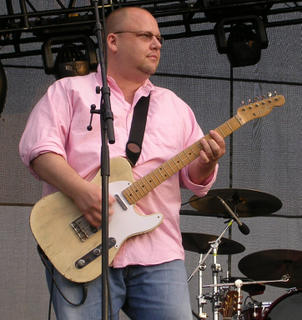 "And now for the fun stuff," said Perry Farrell to an eager audience looking to see the Pixies make their appearance. Since reforming at the 2004 Coachella Valley Music Festival in Indio, California, the Pixies remained a hot ticket, selling out five consecutive nights at the Aragon Ballroom just this past November in Chicago. As the only band brought back from the failed Lollapalooza 2004 lineup, the Pixies took a co-headlining position alongside Weezer. Farrell wrapped up his introduction by calling the Pixies, "One of the seminal rock bands of the 80's." Facing the Chicago skyline, the Pixies delievered the usual standards that have been part of their reunion set for a year. Fans still roared to the sounds of "Head On," "Debaser," and "Where Is My Mind?"
"And now for the fun stuff," said Perry Farrell to an eager audience looking to see the Pixies make their appearance. Since reforming at the 2004 Coachella Valley Music Festival in Indio, California, the Pixies remained a hot ticket, selling out five consecutive nights at the Aragon Ballroom just this past November in Chicago. As the only band brought back from the failed Lollapalooza 2004 lineup, the Pixies took a co-headlining position alongside Weezer. Farrell wrapped up his introduction by calling the Pixies, "One of the seminal rock bands of the 80's." Facing the Chicago skyline, the Pixies delievered the usual standards that have been part of their reunion set for a year. Fans still roared to the sounds of "Head On," "Debaser," and "Where Is My Mind?" But the Pixies acted very distant as they flipped through their songs like you would flip through a magazine where you simply look at the pictures. They might have been working off the set list they intended to use for their headlining spot on last year's Lollapaloooza. Interaction with the crowd was nonexistent. When you've cashed a check for a reported $270,000 then maybe there's no obligation to have to talk to a crowd.
But the Pixies acted very distant as they flipped through their songs like you would flip through a magazine where you simply look at the pictures. They might have been working off the set list they intended to use for their headlining spot on last year's Lollapaloooza. Interaction with the crowd was nonexistent. When you've cashed a check for a reported $270,000 then maybe there's no obligation to have to talk to a crowd.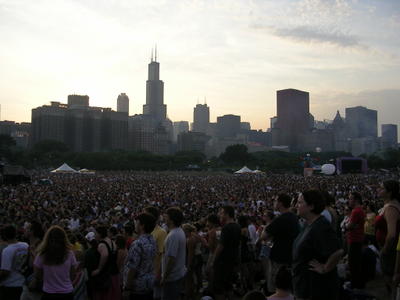
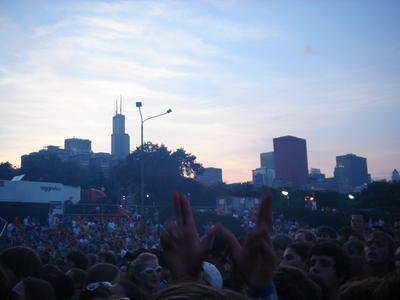 ##Photo By: John Castaneda
##Photo By: John Castaneda Park District Superintendent Tim Mitchell joined Farrell on stage before Weezer arrived for their set. The day had ran smoothly, and Mitchell's face, as he scanned the 33,000 in attendance, conveyed a sense of satisfaction; that organizing this festival might be a good thing for the city afterall. But the attention was soon redirected to Rivers Cuomo and company as they grabbed their instruments and sent the crowd into a frenzy with the opener "Say It Ain't So." Weezer mixed the old with the new and made more of a connection with the crowd than the Pixies had done. Cuomo struck the occasional rock guitarist pose, feeding off the crowd and making every song count. Watching Patrick Wilson work behind the drumkit was like being able to see a younger Bun E. Carlos of Cheap Trick--each possessing flare and power with the drums. "We're so happy to be a part of Lollapalooza, finally," said Cuomo to the sea of hands forming W's in the air, chanting the band's name.
Park District Superintendent Tim Mitchell joined Farrell on stage before Weezer arrived for their set. The day had ran smoothly, and Mitchell's face, as he scanned the 33,000 in attendance, conveyed a sense of satisfaction; that organizing this festival might be a good thing for the city afterall. But the attention was soon redirected to Rivers Cuomo and company as they grabbed their instruments and sent the crowd into a frenzy with the opener "Say It Ain't So." Weezer mixed the old with the new and made more of a connection with the crowd than the Pixies had done. Cuomo struck the occasional rock guitarist pose, feeding off the crowd and making every song count. Watching Patrick Wilson work behind the drumkit was like being able to see a younger Bun E. Carlos of Cheap Trick--each possessing flare and power with the drums. "We're so happy to be a part of Lollapalooza, finally," said Cuomo to the sea of hands forming W's in the air, chanting the band's name.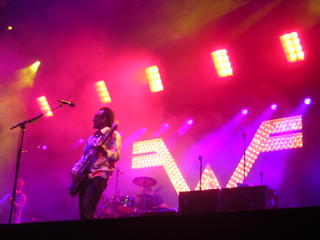 Lollapalooza's first day was a success. The weather never caused any detours, and the heat was replaced by moderately cool tempertures. The early afternoon sets saw an overcast of clouds while the sun finally broke out in the early evening hours to provide a pleasurable setting. Organizers may have breathed a sigh of relief by the end of the night, but there was still one more day to go.
Lollapalooza's first day was a success. The weather never caused any detours, and the heat was replaced by moderately cool tempertures. The early afternoon sets saw an overcast of clouds while the sun finally broke out in the early evening hours to provide a pleasurable setting. Organizers may have breathed a sigh of relief by the end of the night, but there was still one more day to go.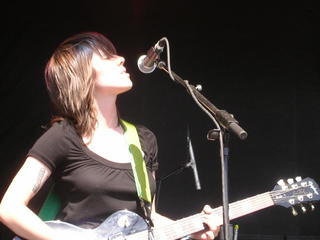 Sunday's weather was expected to reach 100 degrees with a humidity level thick as a brick wall. The wind that would blow through the field would pick up the dirt off the baseball diamonds and become a gust of warm, dusty wind. A security guard working the Parkways Stage, part of a security company from Iowa, described how the heat played into their hands to keep crowds in control. Basically, everyone was too tired to argue with security. Keeping the crowds in control weighed less than keeping the crowds hydrated, which organizers and security accomplished very well. Water stations were in place to allow people to refill their water bottles. Free ice and water was given to people in crowds. When the music wasn't coming from any of the stages there was a quiet air to the fest. People sought out shade and water as fast and as often as they could.
Sunday's weather was expected to reach 100 degrees with a humidity level thick as a brick wall. The wind that would blow through the field would pick up the dirt off the baseball diamonds and become a gust of warm, dusty wind. A security guard working the Parkways Stage, part of a security company from Iowa, described how the heat played into their hands to keep crowds in control. Basically, everyone was too tired to argue with security. Keeping the crowds in control weighed less than keeping the crowds hydrated, which organizers and security accomplished very well. Water stations were in place to allow people to refill their water bottles. Free ice and water was given to people in crowds. When the music wasn't coming from any of the stages there was a quiet air to the fest. People sought out shade and water as fast and as often as they could.The sun baked the Parkways Stage as Tegan And Sara performed. The twin sisters made themselves prime targets for the sun by both dressing in black. Sara (seen above) suffered a heat stroke and was unable to carry on with the set. As much of a disappointment to fans, it was surely a disappointment to the band who fought off the weather as best as they could. In the end, health was more important than getting to the next song. Meanwhile at the SBC East stage, Perry Farrell unveiled his group Satellite Party. Like Farrell, the band was over the top, including bassist Tony Kanal of No Doubt, ex-Extreme guitarist Nuno Bettencount, and a dancing trio called the Lolla Girls.
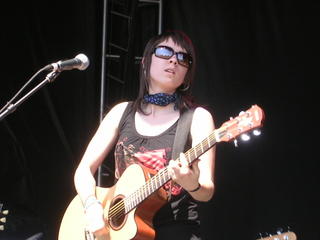
 The Drive-By-Truckers arrived to the SBC West stage with guitar licks and fat bottomed bass; not to mention their own stash of Pabst Blue Ribbon, the drink of choice for these southerners. The heat remained in full effect as evening sets by The Arcade Fire and Spoon proceeded. Widespread Panic was alotted two and a half hours split into two time slots. The jam band restrained themselves and stuck to songs during their 6:30 P.M. slot and saved the marathon jam fests for the final headlining spot. The real anticipation was reserved for The Killers.
The Drive-By-Truckers arrived to the SBC West stage with guitar licks and fat bottomed bass; not to mention their own stash of Pabst Blue Ribbon, the drink of choice for these southerners. The heat remained in full effect as evening sets by The Arcade Fire and Spoon proceeded. Widespread Panic was alotted two and a half hours split into two time slots. The jam band restrained themselves and stuck to songs during their 6:30 P.M. slot and saved the marathon jam fests for the final headlining spot. The real anticipation was reserved for The Killers.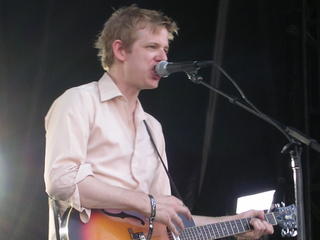
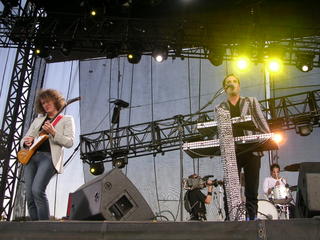 The Killers have gone from a band with some buzz to a band you can not escape. While their debut album Hot Fuss as been one of the most successful EPs in the guise of an album, the heavy momentum for The Killers as continued to carry them higher and higher. Singles like "Somebody Told Me," "Mr. Brightside," and "All These Things That I've Done" all seem to have hit the airwaves at the right time, keeping this Las Vegas band fresh in the ears of listeners. Singer Brandon Flowers embraced Perry Farrell after his introduction and as soon as "Jenny Was A Friend Of Mine" hit its first note, The Killers owned the crowd. Maybe to fans gathering for Death Cab For Cutie at the Budweiser Select stage, The Killers did not deserve their time. The Killers certainly don't scream "indie," but you had to wonder if their performance of the tongue in cheek "Indie Rock And Roll" wasn't directed towards those that act the role of musical connoisseur.
The Killers have gone from a band with some buzz to a band you can not escape. While their debut album Hot Fuss as been one of the most successful EPs in the guise of an album, the heavy momentum for The Killers as continued to carry them higher and higher. Singles like "Somebody Told Me," "Mr. Brightside," and "All These Things That I've Done" all seem to have hit the airwaves at the right time, keeping this Las Vegas band fresh in the ears of listeners. Singer Brandon Flowers embraced Perry Farrell after his introduction and as soon as "Jenny Was A Friend Of Mine" hit its first note, The Killers owned the crowd. Maybe to fans gathering for Death Cab For Cutie at the Budweiser Select stage, The Killers did not deserve their time. The Killers certainly don't scream "indie," but you had to wonder if their performance of the tongue in cheek "Indie Rock And Roll" wasn't directed towards those that act the role of musical connoisseur.When Death Cab For Cutie did hit the stage the night was near its end. Lollapalooza had survived the rain, the heat, and managed to run close to schedule. But there was still an aspect to the newly designed festival that didn't quite live up to its reputation. That one element was diversity. The four stages in Hutchinson Field were mainly an all-rock affair. Across S. Columbus Drive was the Planet Stage, the lone area to catch any sort of hip-hop or house music acts. This section of the park felt more like a small block party that happened to be next door to a major music festival. They were outsiders to a festival just a few feet away. Only the Digable Planets, Saul Williams, and G Love & Special Sauce had the opportunity to take on some of the main stages in the park. Organizers may want to reconsider the festival's configuration if it wants to create a real, diverse musical atmosphere.
The question of whether or not Lollapalooza will every capture the sparkle of magic it displayed in the early 90's is irrelevant by 2005. The festival is whatever the bands and the fans make it. There's a reason why critics do not closely examine Coachella or the Austin City Limits Festival--they are relatively young festivals without the body of history Lollapalooza has amassed in its time. Lollapalooza emerged at the right place and the right time. For now, Perry Farrell should be happy with the new home for his festival. Chicago should realize that the city is now in a position to contend with cities like Austin, Texas that have been synonymous with music festivals. Lollapalooza will be able to attract the types of artists that people may not be able to see at annual fests like the Chicago Blues Fest or the Taste of Chicago.
The beginning of a beautiful relationship? So far, so good.
Thursday, July 21, 2005
Tom Petty And The Heartbreakers @ Tweeter Center (7/15/2005)
 "Even the losers get lucky sometimes"
"Even the losers get lucky sometimes"And sometimes the luck turns bad. I was able to experience both sides of the coin at the Tweeter Center in Tinley Park, IL, just outside of Chicago. In their first appearance in two years since taking up residency at the Vic Theatre for a five night romp, Tom Petty and The Heartbreakers returned to a sold out Tweeter Center. As Petty annouced to the vast crowd of 30,000, "Tonight we have an All-American rock 'n' roll show."
Like most rock 'n' roll shows traffic shares a bit of the spotlight. For me, it had been over two years since I saw a show at the Tweeter Center. (My previous visit was for The Who, the first time I truly understood why so many concertgoers complained about the venue.) The hour wait to be parked at the back end of a field added to the stress held on reserve for the hour plus endurance fest I knew I would have to deal with when leaving. The waiting is the hardest part. Sound wasn't going to be an issue for me since I had the good fortune of being granted a photo pass for the show. I could only imagine how it would sound for the thousands on the lawn who are forced to deal with the pavilion's lousy configuration. I've watched shows from the lawn before, but The Who's 2002 show revealed to me how the pavilion's second level box seats traps so much of the sound. You would be better off sitting at home with a concert DVD. Amphitheaters like Alpine Valley in East Troy, Wisconsin and Shoreline Amphitheater in Mountain View, California have open pavilions that provide a strong sound and visual experience.
As my eyes glanced over the crowd from the photo pit, a sudden rush came over me. I was actually nervous about taking pictures in front of 30,000 people. It was strange. I told one of the photographers, a veteran and good aquaintance of mine, and he slightly laughed. I suppose when I begin to find reviewing or photographing concerts to be an absolute bore is when I lose my soul and become some bitter, old rock critic wrapped up in my personal record collection.

Tom Petty must wake up every morning thanking the powers that be that at his age he is at his utmost best. As classic a sound Tom Petty and The Heartbreakers have made for themselves, they have also maintained a level of excitement that has kept the band fresh on stage. Since original drummer Stan Lynch left the group in 1994 and the death of ex-bassist Howie Epstein in 2003, Tom Petty has managed to keep the ship steady.
 With current drummer Steve Ferrone, multi-instrumentalist Scott Thurston, and original bassist Ron Blair (whom Epstein replaced in 1982), the overall band was functioning like some seasoned race horse. To label the show as a run through the "greatest hits" would be fair but nothing negative. The first eight songs ranged between ten and thirty years old with the exception of a raunchy new song called "Turn This Car Around." The band's last studio release was 2002's The Last DJ, and nothing from that album got played in the mix. The breeze felt by the opening song "Listen To Her Heart" said all that needed to be said by the band: we love our songs. They are a band proud of their catalog and have no reservations about reaching back. Their modern day endeavors prior to The Last DJ--Petty's solo album Wildflowers (1994), the 1995 soundtrack to She's All That, Echo (1999)--have all been outstanding, each in their own way.
With current drummer Steve Ferrone, multi-instrumentalist Scott Thurston, and original bassist Ron Blair (whom Epstein replaced in 1982), the overall band was functioning like some seasoned race horse. To label the show as a run through the "greatest hits" would be fair but nothing negative. The first eight songs ranged between ten and thirty years old with the exception of a raunchy new song called "Turn This Car Around." The band's last studio release was 2002's The Last DJ, and nothing from that album got played in the mix. The breeze felt by the opening song "Listen To Her Heart" said all that needed to be said by the band: we love our songs. They are a band proud of their catalog and have no reservations about reaching back. Their modern day endeavors prior to The Last DJ--Petty's solo album Wildflowers (1994), the 1995 soundtrack to She's All That, Echo (1999)--have all been outstanding, each in their own way.What was so evident as the band played on was how well Petty has a masterful handle on making the harmonies the song's primary hook. "Free Fallin'" and "I Won't Back Down" soared with their pristine Rickenbacker tones resonating throughout the night air. Then came some bad news. During "Last Dance With Mary Jane," a representative of Tweeter Center entered the photo pit to inform the photographers that they all had to exit. When I was told the news I was slightly confused, a feeling shared by each photographer as I read their faces in reaction to the new developments. We were all told that Tom Petty's photo policy encouraged photographers to shoot as much of the show as they would like, thus giving photographers the freedom to remain in the photo pit for the entire show. Generally, the standard photo policy for any band is photographers are allowed to shoot the first three songs of a set and then must leave. As I left the pit area at the end of the song, I wondered how I was going to review the concert if I couldn't see it. The photo pass was my only access since review passes were no longer available. Unless someone had a free ticket to the show I had no way back, either to the lawn area or pavilion.
I was told that it was tour management for Petty that made the decision to reverse their policy. I headed out to the parking lot, feeling cheated, as "Handle With Care" rocked on in the background. My emotions soon changed to concern about locating my parking spot since where I had parked had no lights of any kind to illuminate the cars.
After some searching and squinting in the darkness, I found my car, maneuvered carefully out of the tightly confined space, and watched the Tweeter Center fade in my rearviewmirror. I thought two things: I got to watch one of the most amazing bands closer than anyone in the crowd and that at any time, management can step in to say, "We changed our minds." But couldn't they have at least held off till after "Runnin' Down A Dream"?
Well, at the end of my night, I didn't burn Tom Petty albums.
*All Photos By: Chris Castaneda*
Tuesday, July 19, 2005
Play Or Nay
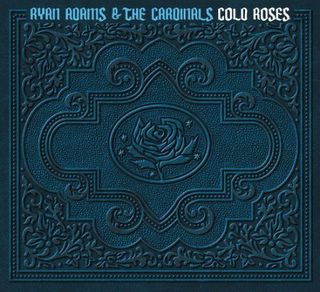
Ryan Adams & The Cardinals - Cold Roses (Lost Highway)
As a song title, "Sweet Illusions" really sums up the latest effort by Ryan Adams. What a sweet illusion his career has been from Whiskeytown to the present day, over eight years. He's been deemed a bad boy to a heart-on-his-sleeve songwriter. He is a musician of clear promise trapped by the walls of his own creation. On the double album Cold Roses, Adams laments from one song to the next without ever reaching for a new box of Kleenex.
Double albums always come with some dodgy turf. The excess of material tends to raise the argument that some songs could have been cut to make a more focused single album. Adams has had some trouble maintaining a tight aim since 2002's Demolition, a collection of unreleased demos. In 2003, Adams readied an album called Love Is Hell, but his record label told him to go back to the drawing board. Instead, Adams released the abysmal Rock N Roll--a jean jacket, amped up, blood, sweat and beer affair that came nowhere near its rock star diva persona. At the same time, Adams had his way by having Love Is Hell broken into two EPs, almost as if saying to listeners, "Here's what I really wanted to release but was told is wasn't good enough." Just last year the Love Is Hell EPs were released as a full album, and, according to Adams, Cold Roses will be the first of three releases Adams has in store for this year. Call it massive creative output or just clearing out the closet.
But Cold Roses is nothing more than a frigid album with very few moments of warmth. The second "Magnolia Mountain" begins disc one to the end of "Friends" on disc two there's never the sense of cohesion. Both albums run in a very stark, lackluster pace with Adams taking a slow drag with every word he sings. It's almost like Adams recorded the whole album on fifteen minutes of sleep. Over eighteen songs, Adams hits a redeemable note on "When Will You Come Back Home." Sure, it's still one song in a catalog of songs that deal with the same story: the brokenhearted soul yearning for the unattainable girl, drowning sorrows at the bar. Maybe that's forever Adams' forte as a songwriter. An album's worth of "When Will You Come Back Home" may not have made for a better album, but spreading the magic of that song across the rest of the album wouldn't have hurt.
Whether or not he'll ever expand his creative scope in the manner of which songwriters like Paul Westerberg, Jay Farrar and Jeff Tweedy have done in their careers--artists often said to be Adams' measuring stick--Adams remains at the end of the bar near the jukebox, close enough to select the usual tunes.
Wednesday, July 13, 2005
Extra! Extra! Mid-Year Delights
 Oasis – Don’t Believe The Truth (Epic) – Since Jim immortalized me in his Oasis concert review I have to list this album just to spite him and continue our behind-closed-doors debate. I still don’t know who Jim DeRogatis is anymore.
Oasis – Don’t Believe The Truth (Epic) – Since Jim immortalized me in his Oasis concert review I have to list this album just to spite him and continue our behind-closed-doors debate. I still don’t know who Jim DeRogatis is anymore. Star Wars : Episode III – Revenge of the Sith (Sony Classical) – Who says an original motion picture score can’t stand along side a rock album? By far, John Williams’ finest work to date.
Star Wars : Episode III – Revenge of the Sith (Sony Classical) – Who says an original motion picture score can’t stand along side a rock album? By far, John Williams’ finest work to date. Queens of the Stone Age – Lullabies to Paralyze (Interscope Records) – There’s enough twists and turns to keep me wanting to hear more. “Long Slow Goodbye” is sinisterly smooth to the bone.
Queens of the Stone Age – Lullabies to Paralyze (Interscope Records) – There’s enough twists and turns to keep me wanting to hear more. “Long Slow Goodbye” is sinisterly smooth to the bone. Son Volt – Okemah and the Melody Riot (Transmit Sound/Legacy) – Farrar makes his most energetic solo album under the Son Volt name. Farrar has nothing to prove but has a lot to say.
Son Volt – Okemah and the Melody Riot (Transmit Sound/Legacy) – Farrar makes his most energetic solo album under the Son Volt name. Farrar has nothing to prove but has a lot to say.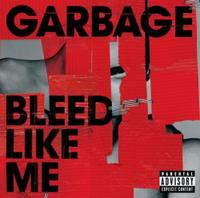 Garbage - Bleed Like Me (Geffen Records) - The album starts off by lifting lines from Foreigner's "Hot Blooded." I got the joke. Fortunately, the rest of the album wasn't.
Garbage - Bleed Like Me (Geffen Records) - The album starts off by lifting lines from Foreigner's "Hot Blooded." I got the joke. Fortunately, the rest of the album wasn't.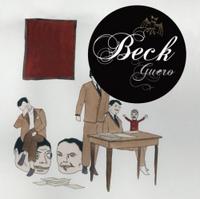 Beck - Guero (Interscope Records) - Listening to this album is like walking knee deep in mud and actually enjoying it.
Beck - Guero (Interscope Records) - Listening to this album is like walking knee deep in mud and actually enjoying it. The White Stripes - Get Behind Me Satan (V2 Records) - Oh my god! They can write songs that all don't sound like "Fell In Love With A Girl." Now, if only Jack can dump the shtick about Meg being his sister.
The White Stripes - Get Behind Me Satan (V2 Records) - Oh my god! They can write songs that all don't sound like "Fell In Love With A Girl." Now, if only Jack can dump the shtick about Meg being his sister. Doves – Some Cities (Capitol) – This other band from Manchester, England went for the straightforward approach and came up with gems like “Black and White Town” and “Ambition.”
Doves – Some Cities (Capitol) – This other band from Manchester, England went for the straightforward approach and came up with gems like “Black and White Town” and “Ambition.” Stereophonics – Language. Sex. Violence. Other? (V2 Records) – The Black Crowes + Oasis = New Stereophonics Album. “Dakota” deserves to be among the summer’s best singles.
Stereophonics – Language. Sex. Violence. Other? (V2 Records) – The Black Crowes + Oasis = New Stereophonics Album. “Dakota” deserves to be among the summer’s best singles. Coldplay – X&Y (Capitol) – I concede. Coldplay won me over with an album that is both daring and fresh, not to mention has Oasis’ Definitely Maybe to thank for even being made.
Coldplay – X&Y (Capitol) – I concede. Coldplay won me over with an album that is both daring and fresh, not to mention has Oasis’ Definitely Maybe to thank for even being made.*The Sound Opinions crew have compiled lists of their best of the mid-year. My list is based on albums that are under my roof, bear the seal of 2005, and have been given more than one listen. To read the entire crew's list, check out the Sound Opinions site and click the "Best of 2005 (so far)" image.
Tuesday, July 12, 2005
Play Or Nay
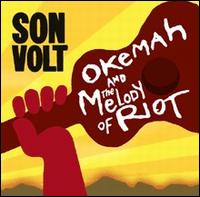
Son Volt - Okemah And The Melody Of Riot (Transmit Sound/Legacy)
"Bandages & Scars" seems an appropriate title as the lead off track of the first Son Volt album in seven years. While the title may suggest the thumps Jay Farrar took from his former bandmates in reforming the band, it is just a small stroke to a larger painting Farrar is presenting.
It might be said that Jay Farrar and Son Volt are one in the same. How listeners distinguish between a solo effort and a band effort is by simply looking at whose name is on the album. That's all well and fine. But for some Son Volt fans, it's been a good wait since 1998's Wide Swing Tremolo. Original members Dave and Jim Boquist and Mike Heidorn, Farrar's drummer since Uncle Tupelo, took a pass on a new Son Volt album. What they have taken a pass on is an excited Farrar on an electric guitar with things to say.
The album's title references Woody Guthrie's hometown of Okemah, Oklahoma. The political consciousness of Guthrie seems to have rubbed off on Farrar; clearly evident in the line, "The words of Woody Guthrie ringing in my head." On "Jet Pilot," President George W. Bush and his father, former President George H. Bush Sr., take the blunt end of Farrar's pen. To say Farrar is soft with his criticism of President George W. Bush and the conflict in Iraq, that would be an understatment. "Endless War" voices the sentiment, "Still trying to understand/How another wrong makes a right." Farrar isn't suddenly stepping into the spotlight of political activist, but he is commenting as an individual, a citizen, a husband, and a father on the world he lives in.
It seems that Son Volt has opened a new chapter for Farrar. Okemah And The Melody Of Riot is the most potent collection of material from Farrar in recent years. "6 String Belief" and "Afterglow 61" capture Farrar's still burning fire for rock and roll and its optimism that it can carry in an age of cynicism. But it's the album's final moments that gives it a graceful conclusion. "World Waits For You" places Farrar at the piano. Its flowing soulfulness receives a boost from his gentle delivery which give it a romantic touch.
It is Farrar's newfound musicality that has brought a breath of fresh air to a band that has been dormant for seven years and a songwriter who hasn't lost sight of the bigger picture.
Monday, July 11, 2005
Thunderfingers. The Ox. Entwistle.
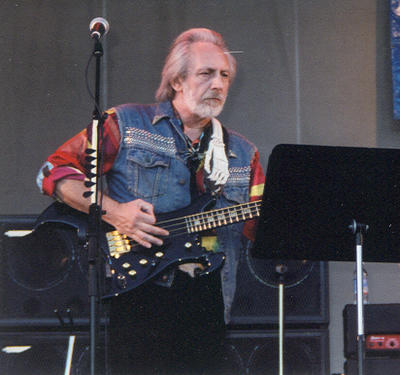 Taste of Chicago - July 5, 2001 (Photo By: Chris Castaneda)
Taste of Chicago - July 5, 2001 (Photo By: Chris Castaneda)It was one of those perfect Chicago summer days: the humidity wasn't too high, and the breeze from the lake front was just right.
One day after Wilco's successful headlining of the WXRT Free 4th of July concert at Grant Park, John Entwistle joined Alan Parsons, Ann Wilson of Heart, and Todd Rundgren for a Beatles tribute show titled "A Walk Down Abbey Road." The fact that the famed Who bassist was going to lay his fingers on songs penned by a peer group from the British Invasion of the 1960's was almost too irresistible to pass up.
Little did anyone know that almost a year later in a Las Vegas hotel room the 57-year-old Entwistle would be gone, dead from a heart attack attributed to cocaine. Like his former bandmate Keith Moon, who died in 1978 of a drug overdose, Entwistle's death was considered "accidental" by the medical examiner. Hearing the news made my knees buckle. Fans of The Who that remember the day they heard the news of Keith Moon's death probably felt the same way. All you can try to do it make sense of the whole situation. Here was a man, Entwistle, who was in the unique position as a musician of being in the absolute prime of his abilities. It's the rock 'n' roll mentality that the older you get the less you can capture the fire of your youth. For Entwistle, it didn't seem that hard to accomplish. His statue-esque presence on stage never altered, but his fingers always remained in a fury.
My introduction to The Who was when I was 15 and I rented the documentary The Kids Are Alright (1979). Whenever I went to the nearby video rental store I always headed towards the music video section. Once I decided I rented all their copies of R.E.M. videos one too many times, I randomly picked The Who mainly because of the original VHS box it came in. The image that struck me the most on the box was Pete Townshend--bearded, right fist in the air, legs spread apart while his left hand was squeezing some power chord. I knew not one Who song. But as I watched Townshend destroy his equipment and Moon thrash his drum kit to pieces during an appearance on a 1967 episode of The Smothers Brothers Comedy Hour I picked up my jaw from off my bedroom floor and popped my eyes back into their sockets. "My Generation" had just redefined everything I thought I knew about rock music up to that point. I went from wanting to be Peter Buck of R.E.M. to wanting to be Pete Townshend.
By the time of my 16th birthday, my father had bought me a copy of The Who's second rock opera, Quadrophenia (1973). He had ragged on me for playing too much Who in the house but stood by Quadrophenia as his favorite Who album (probably since he saw the band in 1973 at the International Amphitheater in Chicago). As part of my birthday breakfast, he allowed me the chance to play the album on his stereo. It was quite the honor back then to even touch my dad's stereo system. All he could talk about was how great a song "Punk And The Godfather" was and how the show he saw was amazing.
 Taste of Chicago - July 5, 2001(Photo By: Chris Castaneda)
Taste of Chicago - July 5, 2001(Photo By: Chris Castaneda)July 20, 1997--my dad got a phone call from a friend that had tickets for a show that he couldn't make and asked if my dad would be interested in going instead. I was called to the living room where my dad was conversing over the phone. "Do you want to see The Who? I can't go."
Oh my stars. I probably fumbled my words before I could finally say, "Yes." The Who were touring Quadrophenia and were performing that day at the beloved New World Music Theatre out in Tinley Park. I'm being slighty sarcastic about the venue, now called the Tweeter Center. It's rather hated by many for its horrendous sound as a venue. I didn't care at that moment though. Two tickets were offered to me. Now the only question was who would I go with? Well, that came easy. I asked the one friend who had his license already and a car. So, I called my friend and within 15 minutes we were off to experience The Who live. It's funny to think back to how those tickets sent our egos skyrocketing. Box seats. VIP parking. What more could two 16-year-olds ask for?
The show was incredible. Quadrophenia had been my soundtrack to being 16. To me, it summed up everything about being a teenager. Next to my personal favorite "I'm One" was the highlight performance of "5.15". Taking the spotlight was Entwistle and his gargantuan bass solo. From the second Roger Daltrey screamed out "Then I heard thunder," Entwistle stepped in and took over the song. I couldn't believe the speed of his fingers or the sound he created from his corner of the stage. You felt each note rattling your teeth.
I walked away from that show having felt I just saw one of the great rock bands ever still playing like they were one of the greats. Minus Keith Moon, I still felt the spirit of The Who was alive and well. I can still picture Townshend standing at the edge of the stage as "Who Are You" was rumbling to an end and seeing him launch his guitar straight up into the air. And I still remember the gentleman in the next box seat that did his best Keith Moon air drum impression throughout the entire show.
I would have the chance to see The Who one more time in 2000 at the Hollywood Bowl. When Entwistle returned to Chicago for the Beatles tribute in 2001, The Who continued talk of a new album and more touring. On that July day in Grant Park, Entwistle gave a weight to Beatles songs I never thought was possible. His performance with the tribute band made me wonder what he would have been like as the bassist for The Beatles. The dimensions he added to songs like "Day Tripper" and "The End" were a testament to the high level of musicianship he had immersed during his many years of performing.
On June 27, 2002, I took an acoustic guitar to a cafe I usually performed open-mic shows at to do a small tribute to the news that Entwistle died. I played what I knew off the top of my head: "Pinball Wizard," "I'm One," and "Baba O'Riley." Someone came up to me afterwards and thanked me for my set and pointed out the black armband he wore for Entwistle.
I had tickets to see The Who on their '02 tour for shows in Chicago and Indianapolis-Noblesville. Townshend and Daltrey marched on with the tour. I honestly didn't think they should have gone on with that tour. The Chicago performance, which made me realize why the Tweeter Center was detested, left me feeling unexcited but the following night down in Indianapolis--a show I almost missed due to missing an exit and near entry into Ohio--I saw a glimmer of The Who fire that gave me hope. The hope it gave me was that The Who name wasn't being soldiered on for the purpose of living up to the reputation of the name. Entwistle's absence was evident in each song. It's often said that the drummer is always the backbone to any band, but for The Who it was Entwistle. He was the pure musician of the band. Whenever Moon pounded every piece of his kit under 30 seconds or Townshend windmilled his solos, Entwistle kept some form of a foundation intact. He had a sixth sense when it came to Moon and Townshend.
Although I felt the '02 should never have happened I later reversed my opinion. On the eve of a major tour, The Who had to consider the people involved with the tour. There's that one lighting tech who may depend on the summer stint with the band to make ends meet. Probably much of their road crew had been with the band for many years and that's the only job they have for several months of the year. But the tour became a form of therapy. When John Lennon was killed people played Beatles music. When Freddie Mercury died Queen put on a tribute concert. For Who fans, they went to see The Who play Who songs.
Entwistle left a mark that was his own and can never be touched. The debate whether or not a band's name means anything anymore after an original member passes away will swing back and forth. Some say The Who stopped being The Who when Moon died, and some say as long as Townshend picks up a guitar The Who remain The Who. What can't be debated is Entwistle's contributions to the music. He was the constant, the guiding light, to a sound that made the Big Bang seem like a thundercracker on the 4th of July.
Friday, July 08, 2005
Extra! Extra!
The July issue of Chicago Innerview is now available on-line. This month's issue is a special edition covering the upcoming Lollapalooza and Intonation festivals.
I contributed a small write-up on Broken Social Scene, who will be performing as part of Pitchfork's Intonation Music Festival on July 16.
I contributed a small write-up on Broken Social Scene, who will be performing as part of Pitchfork's Intonation Music Festival on July 16.
Wednesday, July 06, 2005
Play or Nay

Coldplay - X&Y (Capitol)
You know your band is doing something right when one of the most prestigious newspapers in America labels you as "the most insufferable band of the decade" when the actual decade is only at its halfway mark. That was the honor bestowed upon Coldplay by The New York Times, and all they did was make their third album.
All that measly third album did for Colplay was claim the #1 spot on Billboard for three weeks until a good, old country singer named George Strait brought the "yeehaw" back to America. Not only was this the band's first #1 album in America but it was also the first U.K. album to hold the position since Radiohead's 2000 album Kid A. When it means more to be a global sensation in the blink of an eye than having a career, Coldplay have proven they are much more than pretenders who happened to get lucky with a song called "Yellow." Like Radiohead's "Creep," "Yellow" immediately became synonymous with Coldplay's identity as a band. People knew the band from the song. So far, Coldplay's run has in many ways mirrored Radiohead's early three album run. Coldplay's Parachutes (2000) was like a toe in the water. The follow up A Rush Of Blood To The Head (2002) was the full-body plunge that brought even more success with songs like "The Scientist," "In My Place," and "God Put A Smile Upon Your Face." The creative growth and intense focus to make solid albums from start to finish was unmistakable.
Radiohead's Ok Computer (1997) didn't reinvent the wheel of music, it shed the band's former skin and almost gave them a new body. For Coldplay, X&Y does the same job. Already one of the most identifible voices in music, singer Chris Martin and his falsetto delivery soothe with some edge. On the title track "X&Y," Martin floats through movements that echo the quiet menace of Pink Floyd's Roger Waters and the soulful ease of U2's Bono. Jon Buckland accentuates Martin's vocal with some fine guitar work, exploring tonal landscapes without overreaching his abilities. Bassist Guy Berryman and drummer Will Champion propel the band like a steady Krautrock freight train on a level track, but the grooves are never absent. "Square One" has the air of a police stakeout. Berryman and Champion create the sound of the hunt. "Talk" shares credits with Kraftwerk's "Computer Love" and Brian Eno, pioneer of ambient music, lends his services on "White Shadows." Looking towards the likes of Kraftwerk and Eno to give the right touch to their songs demonstrates Coldplay's outward thinking to their music, not allowing themselves to be pegged solely as one type of band.
If this is the sound of a maturing, artistically self-challenging band with ambitious ideas, then being declared "the most insufferable band of the decade" isn't so bad afterall.
Saturday, July 02, 2005
Quote Me
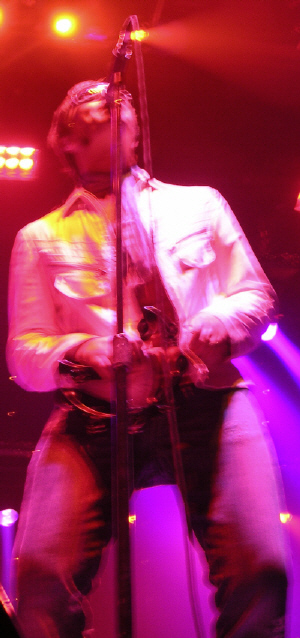
Liam Gallagher @ UIC Pavilion 6/20/2005 (Photo By: Chris Castaneda)
Today, ten concerts will take place in nine different countries as part of the Live 8 benefit. One hundred artists will perform in an effort to grab the attention of the Group of Eight (G8)--a group consisting of the top eight industralized nations in the world. Leaders from the United States, United Kingdom, France, Russia, Japan, Germany, Italy, and Canada are being pressured to cancel Africa's debt and increase aid to combat the grave plight Africa faces day to day.
Organized by Bob Geldof, the mastermind behind 1985's Live Aid benefit, Live 8 comes four days before the G8 summit in Scotland. So, what do Liam and Noel Gallagher of Oasis have to do with the benefit? Absolutely nothing. The benefit is already a buzz due to the reunion of Pink Floyd and its lineup brings together many of music's top artists (R.E.M., Paul McCartney, Coldplay, Green Day, U2). Oasis received criticism for not participating with Live 8 but already had a scheduled concert in Manchester on July 2 before the benefit was even announced. Leave it to Liam and Noel to offer up some noteworthy quotes.
Liam to ChartAttack:
"If we were free we'd be there man. And I am a bit disappointed, but that's life man. Our shows were booked. And I had a word with management the other day, and I said, 'Look, I feel a bit guilty.' Everyone's down there doing all this, know what I mean? We're down the road doing our thing. A little bit of guilt kicked in. I thought maybe we should fucking book... then it's 60,000 kids disappointed.
But if we weren't doing a gig that day we'd have been there without a doubt. And I'd love to. Y'know why I'd love to do that gig? First of all, it's fucking awareness and all that stuff...I just love to go on and do four fucking songs and really fucking rip it up. Come in and fucking bang it with fuckin' four of your classics. And walk off. And fucking flick Robbie Williams in the eye and say 'Follow that you dick!'"
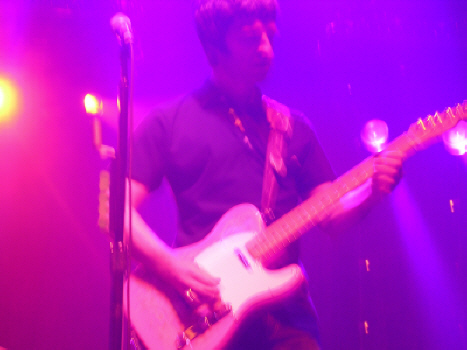
Noel Gallagher @ UIC Pavilion 6/20/2005 (Photo By: Chris Castaneda)
Noel to The Observer:
"I'm not sure about this Live 8 thing. Correct me if I am wrong, but are they hoping that one of these guys from the G8 is on a quick 15-minute break at Gleneagles and sees Annie Lennox singing 'Sweet Dreams' and thinks, 'Fuck me, she might have a point there, you know.' It's not going to fucking happen, is it? Keane doing 'Somewhere Only We Know' and some Japanese businessman going: 'Aw, look at him ... we should really fuckin' drop that debt, you know.' It's not going to happen, is it?"
Noel to the NME:
"If it was possible, it would be nice to take part...It's the general thing that rock stars should be doing something to fucking sort this out. And it's like, 'Well, all right, that's what (U2's) Bono and (Coldplay's) Chris Martin are for.' I don't like the way that somebody suddenly decides that all the bands in England are going to fuckin' play and everybody jumps to attention."
Friday, July 01, 2005
Not Just A Hole In The Wall

Co-owner Tim Tuten of the Hideout (Photo By: Chris Castaneda)
It's interesting how bars and clubs become these grand institutions within a music community. To the neighbors of such places, they can sometimes be thought of as eye sores. For those patrons who earn the distinguished rank of the "regular," they are shrines; home away from home, special haunts where their favorite beer is served or music can be frequently heard. One such local Chicago filling station is the Hideout.
Growing up on the South Side of Chicago, there weren't many options as a 13-year-old to hang out and hear live music. At that time I was still a mallrat with my ragtag group of friends, walking the streets of Calumet City believing the same purpose we all shared in our heads: that we were going to have boundless fun, that our Friday night was going to mean something. I longed for the day I could venture out more often to venues like Lounge Ax, Metro, and Schubas. They were these mythic establishments that I would only hear about on the radio or read about in the newspapers.
Going to DePaul and being surrounded by Lincoln Park was like launching into space and landing on Jupiter. Suddenly I was in arms reach of the music that always vibrated everywhere else but where I lived. I never really felt the restraints of my pre-21 years. I had my choices of all ages or 18 and over concerts, and I still worked my dream job at a record store in Calumet City called Hegewisch Records. Life was fine. I never owned a fake ID. I didn't feel that rush to exceed my age. But a concert here and there would cause a knee jerk reaction. In 2000, I actually considered growing a beard just to see if I could gain access to a 21 and over show by Jeff Tweedy of Wilco at Park West. That was probably the only time I ever felt desperate about not being 21.
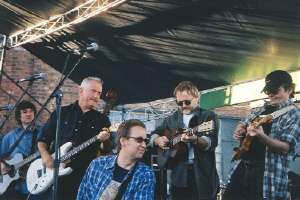
Pine Valley Cosmonauts 9/26/2004 (Photo By: Chris Castaneda)
After December 1, 2001, I was official and the city was open to me. My very close friend, a compatriot from my grammar school and high school days, turned 21 days after me on New Year's Eve. Our major night out as 21-year-olds was to this bar he heard often about in the Chicago Reader. We got directions and ventured off into the night. As we exited onto North Ave. off the Kennedy Expressway, we both reacted to the industrail flavor of the neighborhood. By industrial, I'm not talking Gothic children of the night wandering about and rows of leather bars pumping out Joy Division. We essentially travelled from one dilapidated steel mill neighborhood to another. As he slowly drove us past the Hideout, we both looked at each other and said, "This is it?"
Almost with a deep breath, we took those steps towards the bar probably wondering what we just got ourselves into. The building looked like something from another era but with an Old Style sign hanging over the door. It all evoked this sensation you might have when visiting the grandparents on Thanksgiving or some holiday.

Bobby Bare Jr. 9/26/2004 (Photo By: Chris Castaneda)
But something happened as we walked into the bar. Maybe it was the Christmas lights that hung from the ceiling and around the bar. Or maybe it was the balance of chatter and music that just felt right. It had that blue collar charm of home but it wasn't our home. My friend and I turned and smiled at each other, giving a nod in agreement as if saying, "Ok, this ain't bad." We had chosen our escape.
Fast forward to November of 2002 when I had just seen the Swedish sensation known as the Soundtrack of Our Lives at Metro. Afterwards, I was able to meet three of the six members: Ebbot Lundberg, Ian Person, and Mattias Barjed. My interview with the band's lead singer, Lundberg, had just come out in The DePaulia days before the show. So, it was an obvious thrill to meet the tunic wearing, Shaman-esque singer. While chatting with Person about how the band's tour supporting Oasis went, he invited me to tagalong to the Gingerman Tavern, next door to Metro.
As I entered, I noticed someone sitting at one of the tables in the bar. It happened to be Tim Tutuen, co-owner of the Hideout. In a September article in The DePaulia, I was asked to do a Top-5 Clubs list as a sidebar to an article I had done about the overlooked local band called Verbow. Ranked #2 on my list of local clubs was the Hideout. When the article was published I e-mailed Tuten to let him know that our newspaper mentioned the club. Still very fresh in my rock critic shoes, I didn't expect much of a response back over a college newspaper writing a small blurb about a club, but I got one. Tuten wrote probably one of the nicest responses I had ever gotten from anyone who read my work. I still have it saved in my inbox of my e-mail.
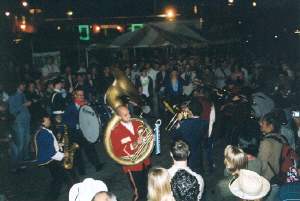
Mocca Pazza Red Moon Marching Band 9/25/2004 (Photo By: Chris Castaneda)
Tuten and I would bump into each other now and then, usually at the Hideout or while in the company of Greg Kot (Chicago Tribune) and Jim DeRogatis (Chicago Sun-Times), my rock critic Zen masters who befriended me early on in my journalistic adventures.
It wasn't until the Hideout's 8th annual Block Party in the fall of 2004 that I truly understood what makes the Hideout the unique club that it is. This wouldn't be the first time I attended the Block Party. I talked my original Hideout companion to come with me to check out Guided By Voices headline a day. For the recent incarnation of the fest, Tuten granted me the best VIP press pass that I don't think will ever be beaten. Being a fellow fan of Paul Weller and The Jam, Tuten had some fun with the pass, which was just an e-mail with big bold letters. I plan on getting it framed one day:
HIDEOUT BLOCK PARTY
2004
VIP PRESS PASS FOR
CHRIS
ALL-ACCESS
ALL DAYS
ALL THE MOD CONS

Marah 9/24/2004 (Photo By: Chris Castaneda)
During the course of September 24-26, the Hideout Block Party drew between 4,500-5,000 attendees. "I slept fifteen hours in three days," said Katie Tuten, wife to Tim and also co-owner of the Hideout. Next to the tasty variety of the twenty-nine band lineup were the notable not-for-profit organizations that received a kind, lending hand from the club. The $14,238.58 raised by the Hideout during the three day fest went towards the charities of CAUSES/Play, Literacy Works, and Tuesday's Child.
Each day I was there had a different vibe. Roaming around behind the main stage I could see there was a real communal sense among the bands and people involved with the fest. The genres of music mixed together on one bill was astounding. For the headliners of the second night, Mouse on Mars, Tim had to clarify to the German group, undertaking their first tour of North America, that the Block Party wasn't some Midwestern ho-down surrounded by cows and barns. On the third day, Bloodshot Records, one of the most venerated Chicago labels, was honored for its tenth anniversary by being given the last day of the Block Party to showcase some of the labels fine acts such as Split Lip Rayfield, the Pine Valley Cosmonauts, and Bobby Bare Jr.
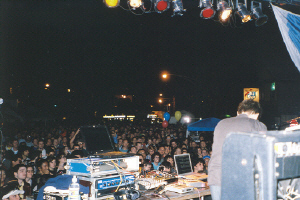
Strong Numbers For Mouse On Mars 9/25/2004 (Photo By: Chris Castaneda)
"It is a lot of work, but we always have a good time," said Katie Tuten. They most certainly do.

Drummer Dodo Nkishi & Jan St. Werner of Mouse On Mars (Photo By: Chris Castaneda)
On the outside, the Hideout looks like your average bar with that slight touch of "dive bar" aura surrounding it, but it's the people inside that make it more than ordinary. It's all about the intangibles when it comes to making a bar or a club extraordinary. There's a reason why five years later people still talk about Lounge Ax as if it were a Chicago legend. We talk about these buildings made of brick as if they were family members, both with their good and bad qualities. Deep down we still love them.
Tim and Katie Tuten and everyone associated with the Hideout have good reason to be proud of their little shack on W. Wabansia St. They are a reminder that heart and soul will always outlive flash and gloss.
Subscribe to:
Posts (Atom)
